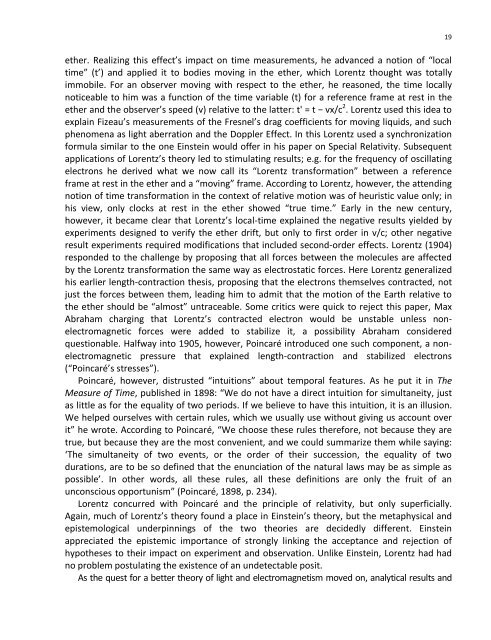- Page 1 and 2: Aprendendo ciência e sobre sua nat
- Page 3 and 4: SUMÁRIO I. EPISÓDIOS HISTÓRICOS
- Page 5 and 6: Estudo de cosmologia moderna no ens
- Page 7 and 8: no estudo desses episódios - por e
- Page 9 and 10: Presentation 1 In Latin America, th
- Page 11 and 12: David Rudge Roberto de Andrade Mar
- Page 13 and 14: el estudio de esos episodios - por
- Page 15: I. EPISÓDIOS HISTÓRICOS
- Page 20 and 21: 20 empirical findings at odds with
- Page 22 and 23: 22 of the century were excellent sc
- Page 24 and 25: 24 The latter include partial law-l
- Page 26 and 27: 26 commendable theory-parts realist
- Page 28 and 29: 28 LYONS, Timothy D. “Scientific
- Page 30 and 31: 30 Na física escolar, as contribui
- Page 32 and 33: 32 XXXi, p. 77 de 1891 - que enfati
- Page 34 and 35: 34 Uma abordagem contextual da ciê
- Page 36 and 37: 36 A visão ondulatória da luz pro
- Page 38 and 39: 38 apresenta-se em termos de equil
- Page 40 and 41: 40 proposto por Huygens, conforme e
- Page 42 and 43: 42 em: . Acesso em: 26 de março de
- Page 44 and 45: 44 MIDGLEY AND THE PERIODIC TABLE:
- Page 46 and 47: 46 de pesquisas envolvendo novos an
- Page 48 and 49: 48 problemas causados pelo envenena
- Page 50 and 51: 50 SbCl 5 3 CCl 4 + 2 SbF 3 3 CCl 2
- Page 52 and 53: 52 uma determinada área da ciênci
- Page 54 and 55: 54 HÖTTECKE, Dietmar; SILVA, Cibel
- Page 56 and 57: 56 concept. We show the conflicting
- Page 58 and 59: 58 Fig. 2. Explicação do torque s
- Page 60 and 61: 60 ou de afastá-lo do fio, tenta f
- Page 62 and 63: 62 O ímã cilíndrico NS flutua ve
- Page 64 and 65: 64 leitores modernos, esta força
- Page 66 and 67: 66 6. AMPÈRE CONTRA FARADAY Ampèr
- Page 68 and 69:
68 9. CONCLUSÃO Ampère foi o prim
- Page 70 and 71:
70 HÖTTECKE, Dietmar & Silva, Cibe
- Page 72 and 73:
72 1. INTRODUCCIÓN En las primeras
- Page 74 and 75:
74 el natural corolario darwiniano
- Page 76 and 77:
76 4. APRENDIENDO DE LA HISTORIA DE
- Page 78 and 79:
78 La investigación de los princip
- Page 80 and 81:
80 LEDERMAN, Norm G. Nature of scie
- Page 83 and 84:
83 ARRHENIUS AND ARMSTRONG: HOW ACT
- Page 85 and 86:
85 2. HENRY ARMSTRONG Arstrog’s u
- Page 87 and 88:
87 in water, therefore, is a proof
- Page 89 and 90:
89 When Arrhenius left Sweden for G
- Page 91 and 92:
91 ionic hydration. No theoretical
- Page 93 and 94:
93 The likig of Arrheius’ ad Arst
- Page 95:
BROCK, William. Introduction to H.E
- Page 98 and 99:
98 chemical content of the lectures
- Page 100 and 101:
100 Tentamos selecionar alguns dos
- Page 102 and 103:
102 Fig.1: Teste com vapor de cera.
- Page 104 and 105:
104 substância é ou não água -
- Page 106 and 107:
106 observou que a limalha se enfer
- Page 108 and 109:
108 mais ser vista. Mergulhou entã
- Page 110 and 111:
110 da atmosfera, e removendo o gá
- Page 112 and 113:
112 discussão de tópicos que são
- Page 114 and 115:
114
- Page 116 and 117:
116 complex concept of inertia, and
- Page 118 and 119:
118 5. GASSENDI AND THE TENDENCY OF
- Page 120 and 121:
120 Rynasiewicz, 1995). Neto’s ac
- Page 122 and 123:
122 publication of the Principia (N
- Page 124 and 125:
124 11. EVIDENCE FOR NEWTON’S FIR
- Page 126 and 127:
126 choice between several other po
- Page 128 and 129:
128 MARTINS, Roberto de Andrade. Na
- Page 130 and 131:
130 the topic soon after the photon
- Page 132 and 133:
132 It was not until 1905 that Eins
- Page 134 and 135:
134 (a) underdetermination of scien
- Page 136 and 137:
136 Table 2: Percentage of Lab Inst
- Page 138 and 139:
138 Criterion 4: Millikan’s presu
- Page 140 and 141:
140 Iowa University, 2007, . Massac
- Page 142 and 143:
142 August 2010. EINSTEIN, Albert.
- Page 145 and 146:
145 UM DIÁLOGO ENTRE A SOCIOLOGIA
- Page 147 and 148:
autônoma em relação às interfer
- Page 149 and 150:
149 em 1974, é apresentar os princ
- Page 151 and 152:
151 justificadamente verdadeira, pa
- Page 153 and 154:
153 que estipulam estágios em uma
- Page 155 and 156:
155 Na escola, quando os estudantes
- Page 157 and 158:
TACON, Ana Claudia & VILELA, Denise
- Page 159 and 160:
159 CRÍTICA À TENTATIVA DE DEFINI
- Page 161 and 162:
161 à física, dos modelos e, em s
- Page 163 and 164:
163 física. Por exemplo, em meados
- Page 165 and 166:
165 etc. Em suma, ser computável
- Page 167 and 168:
167 probabilidade de que um número
- Page 169 and 170:
169 Além das questão de resoluç
- Page 171 and 172:
171 ANÁLISE DE UM TÍPICO ARGUMENT
- Page 173 and 174:
173 (Pessoa, 2010b). 1 Um exemplo b
- Page 175 and 176:
175 processo de amplificação. Uma
- Page 177 and 178:
177 descoerêcia, toraria iviável
- Page 179 and 180:
179 instantaneamente a outra partí
- Page 181 and 182:
181 Einstein, Podolsky & Rosen (193
- Page 183 and 184:
EINSTEIN, Albert; PODOLSKY, Boris;
- Page 185 and 186:
185 VIESES COGNITIVOS E SUAS CONSEQ
- Page 187 and 188:
187 cognitivos, podem funcionar em
- Page 189 and 190:
“egudo os defesores da teoria da
- Page 191 and 192:
191 que requerem prova por contradi
- Page 193 and 194:
193 REFERÊNCIAS BIBLIOGRÁFICAS BR
- Page 195 and 196:
WITTGENSTEIN, Ludwig. Investigaçõ
- Page 197 and 198:
197 O DEBATE REALISMO/ANTIRREALISMO
- Page 199 and 200:
199 realismo/antirrealismo em situa
- Page 201 and 202:
201 conceitos, questões histórica
- Page 203 and 204:
203 inserção em sala de aula prec
- Page 205 and 206:
205 esse resultado como justificati
- Page 207 and 208:
207 na relação matéria-espaço e
- Page 209 and 210:
MATTHEWS, Michael R. Science Teachi
- Page 211:
III. NATUREZA DA CIÊNCIA
- Page 214 and 215:
214 como cultura ampla e como cultu
- Page 216 and 217:
216 está presente nos artigos feit
- Page 218 and 219:
218 Já a tedêcia costrutivista se
- Page 220 and 221:
220 (2002), acreditamos que é impo
- Page 222 and 223:
222 EL-HANI, Charbel N.; MORTIMER,
- Page 224 and 225:
224
- Page 226 and 227:
226 historically led naturalists to
- Page 228 and 229:
228 These considerations led Lederm
- Page 230 and 231:
230 4.2 Pragmatic concerns Others h
- Page 232 and 233:
232 aloe could reveal aythig aout h
- Page 234 and 235:
234 DEBOER, George. A history of id
- Page 236 and 237:
236 research focused on the student
- Page 238 and 239:
238 exclusivamente quantitativos e
- Page 240 and 241:
240 esse questionário também por
- Page 242 and 243:
242 Tabela 1. Tempos de resposta pa
- Page 244 and 245:
244 Tabela 2. Componentes de NdC qu
- Page 246 and 247:
246 Tabela 5. Dimensões e categori
- Page 248 and 249:
248 Tabela 7. Ranking médio das re
- Page 250 and 251:
250 CHEN, Sufen. Development of an
- Page 252 and 253:
252 1. INTRODUÇÃO Este trabalho d
- Page 254 and 255:
254 em questão. E, praticamente de
- Page 256 and 257:
256 tendo em vista os problemas ini
- Page 258 and 259:
258 Resposta: [...]. A teoria não
- Page 260 and 261:
260 Resposta: Jean Buridan era cont
- Page 262 and 263:
262 desses conteúdos pôde-se nota
- Page 264 and 265:
264
- Page 266 and 267:
266 intention is to provide opportu
- Page 268 and 269:
268 modificar uma imagem segregada
- Page 270 and 271:
270 elas serão testadas pelo profe
- Page 272 and 273:
272 ocorre a discussão entre aluno
- Page 274 and 275:
274 comunidade científica, passam
- Page 276 and 277:
276 METZ, Don; KLASSEN, Stephen; MC
- Page 278 and 279:
278 1. INTRODUCCIÓN El presente tr
- Page 280 and 281:
280 Tabla. 1. Diseños de las inves
- Page 282 and 283:
282 Tabla 2. Principales investigac
- Page 284 and 285:
284 dilemas. Los dilemas, a diferen
- Page 286 and 287:
286 Tabla 5. Distribución de dilem
- Page 288 and 289:
288 4.2 El contenido de las concepc
- Page 290 and 291:
290 cuando se traslada el contexto
- Page 292 and 293:
292 Dilema 8-La imagen que se prese
- Page 294 and 295:
294 HOFER, Bárbara; PINTRICH, Paul
- Page 296 and 297:
296
- Page 298 and 299:
298 scientific or non-scientific do
- Page 300 and 301:
300 2. METODOLOGÍA Y PARTICIPANTES
- Page 302 and 303:
302 categorías a los mismos segmen
- Page 304 and 305:
304 Aspectos procedimentales Proced
- Page 306 and 307:
306 cietífico coo ua iage estereot
- Page 308 and 309:
308 LIU, Shiang-Yao; LEDE‘MAN, No
- Page 310 and 311:
310 calidad para todos y todas, es
- Page 312 and 313:
312 Cuadro 1. Tópicos que se deber
- Page 314 and 315:
314 3.2 NOS y epistemología: Una i
- Page 316 and 317:
316 4. INFERENCIAS FINALES Podemos
- Page 318 and 319:
318
- Page 320 and 321:
320 the 125 articles initially sele
- Page 322 and 323:
322 regiões do país e do exterior
- Page 324 and 325:
324 Pegamos os 58 trabalhos que res
- Page 326 and 327:
326 Tabela 5. Relação entre os tr
- Page 328 and 329:
328 FORATO, Thaís Cyrino de Mello.
- Page 330 and 331:
330 outubro, 2004, Jaboticatubas. S
- Page 333 and 334:
333 STUDENTS’ BELIEFS ABOUT THE D
- Page 335 and 336:
335 What exactly do we mean b
- Page 337 and 338:
337 Fig. 1: Dimensions of methodolo
- Page 339 and 340:
339 by applying TWOS. Here, science
- Page 341 and 342:
341 Fig. 3: Source-target model of
- Page 343 and 344:
343 To ensure a better understandin
- Page 345 and 346:
345 Table 1: Inventory of metaphori
- Page 347 and 348:
347 The trustworthiness of TWOS dat
- Page 349 and 350:
349 express their elief i a fiite,
- Page 351 and 352:
351 ideas on what and why something
- Page 353 and 354:
353 in order to …’: E7E6W: Chan
- Page 355 and 356:
355 Table 4: “eve ideal types of
- Page 357 and 358:
357 past science and are shaped by
- Page 359 and 360:
HODSON, D. Teaching and Learning ab
- Page 361 and 362:
ROKEACH, M. Beliefs, attitudes, and
- Page 363 and 364:
363 HISTORIA Y ACTIVIDAD EXPERIMENT
- Page 365 and 366:
365 Ciencias requiere del desarroll
- Page 367 and 368:
367 Una consideración especial mer
- Page 369 and 370:
369 3.2.1 Validación experimental
- Page 371 and 372:
371 una imagen más adecuada de la
- Page 373 and 374:
373 3.3.2 Una observación de contr
- Page 375 and 376:
375 REFERENCIAS BIBLIOGRÁFICAS AD
- Page 377 and 378:
377 DIVULGAÇÃO DO EPISÓDIO DA EX
- Page 379 and 380:
379 utilização de episódios hist
- Page 381 and 382:
deveriam ler o texto do estudo de c
- Page 383 and 384:
383 Os outros alunos não conseguir
- Page 385 and 386:
385 conseguiram perceber que a tecn
- Page 387 and 388:
adoção do pêndulo de segundos co
- Page 389 and 390:
389 STORY INTERRUPTED: USING HISTOR
- Page 391 and 392:
391 reappraisal’ (p. of the role
- Page 393 and 394:
393 I have chosen my example to con
- Page 395 and 396:
395 and students are surprised to f
- Page 397 and 398:
397 SHADOWS OF LIGHT AND HISTORY IN
- Page 399 and 400:
399 Many exercises in critical expl
- Page 401 and 402:
401 response to a candle she lit. I
- Page 403 and 404:
403 discovery! That they took oersh
- Page 405 and 406:
405 I the ureserved uestioig that t
- Page 407 and 408:
407 In this exercise, two highly ed
- Page 409 and 410:
teachers. New Educator 5 (3): 205-2
- Page 411 and 412:
411 ESTUDO DE COSMOLOGIA MODERNA NO
- Page 413 and 414:
413 introduzida, mas genérica ela
- Page 415 and 416:
415 na cosmologia aristotélica, ma
- Page 417 and 418:
417 Um ponto enfatizado nesse momen
- Page 419 and 420:
419 novo olhar de Harriot para a Lu
- Page 421 and 422:
421 possibilitou a emergência de u
- Page 423 and 424:
423 REFERÊNCIAS BIBLIOGRÁFICAS BR
- Page 425 and 426:
425 UMA PROPOSTA DE CLASSIFICAÇÃO
- Page 427 and 428:
427 superior, ao invés de ser um o
- Page 429 and 430:
429 Tabela 1. Razões descritas em
- Page 431 and 432:
431 como um princípio científico.
- Page 433 and 434:
433 Tabela 2. Uma proposta de class
- Page 435 and 436:
435 Tabela 3. Os sete estudos de ca
- Page 437 and 438:
437 Fingon (2009) discutem uma vers
- Page 439 and 440:
439 reencenando os caminhos de Gali
- Page 441 and 442:
441 história da ciência. Este asp
- Page 443 and 444:
443 humanizar a ciência, revelando
- Page 445 and 446:
HEERING, Peter. Getting shocks: Tea
- Page 447 and 448:
447 SERAFINI, A. The epic history o
- Page 449:
V. MATERIAIS INSTRUCIONAIS
- Page 452 and 453:
452 convierte en un problema didác
- Page 454 and 455:
454 a) ¿El profesorado y los libro
- Page 456 and 457:
456 b) ¿El profesorado y los libro
- Page 458 and 459:
458 Tabla 2. Comparación del porce
- Page 460 and 461:
460 FURIÓ, Carles. Tendencias actu
- Page 462 and 463:
462 AN ANALYSIS OF THE HISTORICAL C
- Page 464 and 465:
464 passaram a ficar disponíveis p
- Page 466 and 467:
466 1.5. Experimentos históricos f
- Page 468 and 469:
468 3.7 DESENVOLVIMENTO DA CIÊNCIA
- Page 470 and 471:
470 Tabela 4. Análise do contexto
- Page 472 and 473:
472 individual, já que Mendel real
- Page 474 and 475:
474 Tabela 10. Nota geral de cada o
- Page 476 and 477:
476 MEETING ON CRITICAL ANALYSIS OF
- Page 478 and 479:
478 Abstract: This paper presents t
- Page 480 and 481:
480 agente principal do conheciment
- Page 482 and 483:
482 A utilização da linguagem e r
- Page 484 and 485:
484 cultural que certamente influen
- Page 486 and 487:
486
- Page 488 and 489:
488 samples, (8) Analogies and (9)
- Page 490 and 491:
490 Quadro 1. Obras analisadas dura
- Page 492 and 493:
492 (b) Raios atômicos, Brown (199
- Page 494 and 495:
494 (a) (b) Fig. 8. Exeplos para a
- Page 496 and 497:
496 A combinação das análises ic
- Page 498 and 499:
498 distribuição das ilustraçõe
- Page 500 and 501:
500 Distribuição (%) 10 8 6 4 2 0
- Page 502 and 503:
502 de primeiro ano em um curso de
- Page 504 and 505:
504 ingressantes nos cursos superio
- Page 506 and 507:
506 Apesar da reaproximação dos a
- Page 508 and 509:
508 atuação didática? Qual a abo
- Page 510 and 511:
510 PAULING, L. Química geral. 2a.
- Page 513 and 514:
513 HISTORIA DE LA CIENCIA EN LA FO
- Page 515 and 516:
515 determinados conceptos; qué le
- Page 517 and 518:
517 Ciencia y Formación Docente qu
- Page 519 and 520:
519 Tabla 2. Descripción de las ac
- Page 521 and 522:
521 principal énfasis cómo los co
- Page 523 and 524:
523 con otras áreas del conocimien
- Page 525 and 526:
WANG, H. & MARSH, D. “ciece Istru
- Page 527 and 528:
527 HACIA UNA RECONSTRUCCIÓN DEL C
- Page 529 and 530:
529 La educación química normal e
- Page 531 and 532:
531 teórico (riguroso y sistemáti
- Page 533 and 534:
533 ciencias a otras, como las cien
- Page 535 and 536:
535 una enseñanza basada en la inv
- Page 537 and 538:
537 ANÁLISE DE PRÁTICAS PEDAGÓGI
- Page 539 and 540:
539 perto do universo cognitivo nã
- Page 541 and 542:
541 Foram debatidos ainda, temas re
- Page 543 and 544:
543 Sobre a utilização da Histór
- Page 545 and 546:
545 Quadro 3. Síntese do planejame
- Page 547 and 548:
547 A análise do questionário VOS
- Page 549 and 550:
BARDIN, Laurence. Análise de Conte
- Page 551 and 552:
551 DE LA FILOSOFÍA DE LA CIENCIA
- Page 553 and 554:
553 consideramos que asignaturas co
- Page 555 and 556:
555 Al estructurar de esta manera e
- Page 557 and 558:
557 (4) ¿Por qué es necesaria la
- Page 559 and 560:
559 cabe señalar cierta tendencia
- Page 561 and 562:
561






